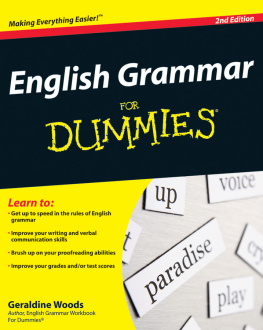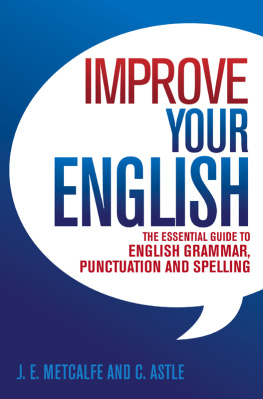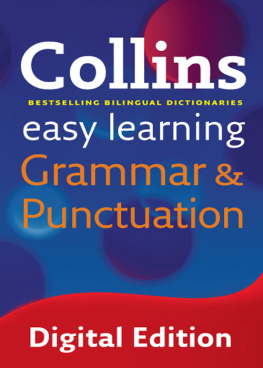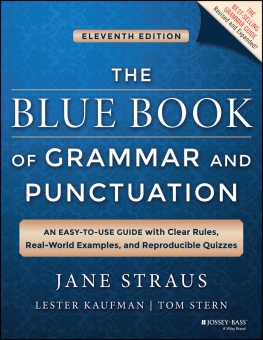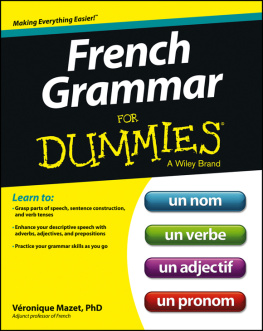P.D. ANTONY
ACKNOWLEDGEMENTS
I would like to express my thanks to Cleitus Antony for designing the book cover with the theme of organic molecular structure , linking my professional background in organic chemistry with the systematic aspect of the structure , rules and conventions of English grammar .
I am very grateful to Maryann Basil for her help and guidance in making this text error - free .
I am also very grateful to the people at Notion Press Media Pvt . Ltd ., for guiding me through the publication process .
Dedicated to my grandson
Sam
and
the student community

Notion Press
Old No. 38, New No. 6
McNichols Road, Chetpet
Chennai - 600 031
First Published by Notion Press 2016
Copyright P.D . Antony 2016
All Rights Reserved.
ISBN 978-1-945688-07-2
This book has been published with all efforts taken to make the material error-free after the consent of the author. However, the author and the publisher do not assume and hereby disclaim any liability to any party for any loss, damage, or disruption caused by errors or omissions, whether such errors or omissions result from negligence, accident, or any other cause.
No part of this book may be used, reproduced in any manner whatsoever without written permission from the author, except in the case of brief quotations embodied in critical articles and reviews.
PREFACE TO THIS EDITION
This grammar guide is designed for students .
Part 1 is for secondary and higher secondary school students . Accordingly the contents thereof , an outline of grammar , have been made simpler and easier for their comprehension and retention . Grammar concepts are explained adequately for their level , but examples and exercises are limited so as to avoid overwhelming or confusing them .
Part 2 provides lengthier explanations , taking into consideration every nuance of grammar within the scope of a grammar book of this size , for undergraduate students . This is , however , not aimed at students or people aspiring to learn very advanced grammar and English usage .
INTRODUCTION
English belongs to the Germanic branch of the Indo- European family of languages. It was brought into Britain by bands of invading Teutons, who migrated from the lowlands of northwestern Germany from the late AD fifth century, over a period of hundred years. In Britain, they found Celtic inhabitants whom they drove out of the plains. The invaders consisted of three tribes: Jutes, Saxons and Angles and they had mingled with well until the Norman Conquest in 1066. They called their adopted country England and their language English. Thus, English became the predominant language in south Britain from as early as the middle of AD sixth century.
Before the Norman Conquest, English was called Anglo-Saxon or Old English.
The influence of the Normans has left English with many French words and several Latin words, as Norman French had many words derived from Latin roots. The study and revival of classical languages in Europe during the Renaissance also brought a great number of Latin and Greek words into English.
By the end of the sixteenth century, English, a Germanic language in origin, had transformed significantly with the addition of considerable Latin elements and a small proportion of words from other sources.
Today, English has the largest collection of words and is the native language of Britain, Ireland, United States, New Zealand, Canada, South Africa, the West Indies and is used widely across the world.
English is a living language unlike old languages such as Latin, Greek and Sanskrit. Any living being changes over time and similarly, the English language and its grammar have changed, which is why Old English gave way to New English , the English of today .
You will find some references in this book to such changes welcomed and accepted by people over the years. All such changes took place gradually, of course, in places where English was the native language, particularly in Britain and the US. We, in India, adopted such changes over a period.
Grammar in any language is, to some extent, scientific, with rules and conventions. However, it is not an exact science like mathematics; for instance, mathematics is the same anywhere, say 4 4 = 16, whereas English, or any language for that matter, is different in its usage in different parts of the world; the difference is often considerable and sometimes incomprehensible.
Repeated wrong usage over a period becomes respectable and accepted. There was a time when a sentence ending with a preposition was not acceptable in English, for instance, who are you looking for? This is accepted now. For whom are you looking? It is now considered outdated and rarely used nowadays. Changes in usage and grammar are effected and regularized by a committee or panel set up from time to time and comprising well-informed language experts such as, academics, reputed newspaper or magazine editors, well-known writers, journalists and men of letters in the US, UK and other places. These efforts are aimed at keeping English a uniform language for all. In spite of this, English exists as British English and American Englishas we say, humorously, two countries divided by a common language.
A few friendly tips on how to approach this book:
Try to understand thoroughly the grammar rules, examples and exercises and thereafter, attempt to construct your own examples and exercises. To practise capitalization and other punctuation, use passages from a good book or a newspaper such as The Hindu, preferably from the editorial or articles of reputed reporters. Copy these without punctuation and try and punctuate appropriately yourself. Check against the original passage for correctness. Use newspaper articles or book passages to identify grammar rules and conventions you have learnt from this book. This could be effective self-study and could provide you with numerous examples to help you consolidate what you have learnt. Repeated practice will help cement what you learned in your memory.
Wish you good luck.
P. D. Antony
Tel: 0487 2311449 / Mobile: 9388430132
E-mail:
PART 1
There are twenty - six letters in the English alphabet , divided into five vowels - a , e , i , o , u - and twenty - one consonants .
A consonant and a vowel join together to form a syllable; a word may have one or more syllables. A short or medium word has one to three syllables whereas a longer word has more than three syllables. In short, pronunciation is possible by syllable or syllables only. Consonants alone cannot make pronunciation possible. Vowels, however, can have speech sounds.
Accent: | English words are pronounced with stress or pitch; this is called accent, the proper use of which makes for a good style of vocal delivery. |
Phrase: | This refers to a group of words in a sentence without a conjugated verb*. |
Clause: | A simple sentence is a clause that consists of a subject and predicate and may also have an object or complement. |
Sentence: | A single clause is a simple sentence, connected by a conjunction to another clause to form a |



